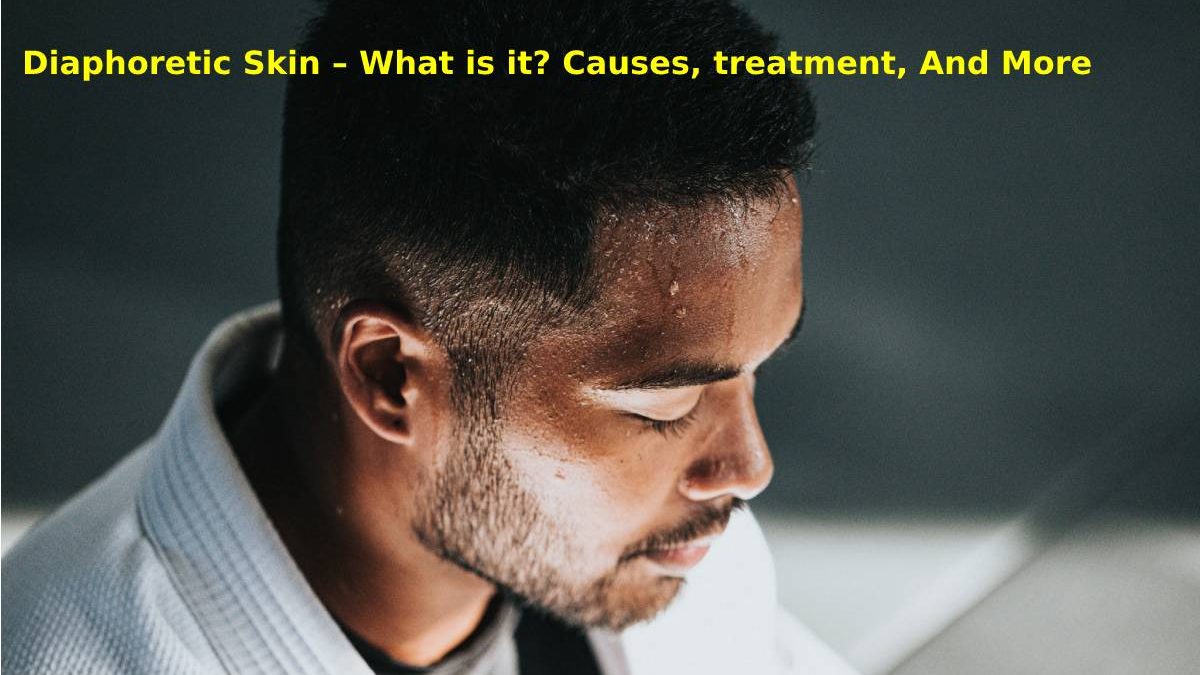Table of Contents
What is Diaphoresis?
Diaphoretic Skin – Diaphoresis, also known as secondary hyperhidrosis is a term used within the field of medicine to refer to excess sweating, rising to levels that are highly disproportionate to the environment in which the individual is (for example, with a temperature low ambient) and your activity level. This excess sweating usually occurs throughout the body and not just in a specific area .Unlike diaphoresis, or secondary hyperhidrosis, which usually causes excessive sweating around the entire body, primary hyperhidrosis usually causes excessive sweating in certain parts of the body only (for example, the legs or feet).
Secondary diaphoresis or hyperhidrosis does not usually occur in isolation but is usually a symptom of some underlying health condition, and in some cases may be serious enough to endanger the life of that person, so it is necessary urgent medical attention. That is why in the next section we will see some of the most common conditions in which diaphoresis can occur.
What Are The Causes Of Diaphoresis?
Unlike primary diaphoresis or hyperhidrosis , in which excessive sweating occurs for no apparent reason, generally limits to specific parts of the body, and in which hyperactivity of the sympathetic nervous system is usually associate, in secondary diaphoresis or hyperhidrosis , there are stimuli that cause it, or some pathological processes or certain drugs are involve, such as:
- heart disease
- Mellitus diabetes
- Drugs of abuse (amphetamines or cocaine)
- hyperthyroidism
- infections
- Medications (analgesics, antibiotics, antidepressants, antimigraine, anxiolytic, anti-inflammatory, antiviral, hypoglycemic, cholinesterase inhibitors, thyroxine, etc.)
- Neoplasms
- Neuropathies (Parkinson’s disease)
- sleep apnea syndrome
- Gastroesophageal reflux
What Is The Treatment of Diaphoresis?
Sweating plays an important role in cooling body temperature when levels are higher than normal, so the brain sends signals to the sweat glands to release sweat, and when the sweat evaporates, it cools down. the surface of the skin, so that the body temperature manages to drop.
Sweating is a normal process, but when it occurs at excessive levels or without an apparent cause, this may be an indication that you are suffering from a problem with going out, as is the case with diaphoresis, for which you may need medical attention.
Diaphoresis is a process of excessive and uncontrollable sweating on the face also , which normally occurs throughout the body, even if the person is not in a favorable environment for this sweating process, nor is the person performing a demanding physical activity that triggers it.
What Is The Proper Management In Case Of Diaphoresis?
If you are one of those who sweat excessively all over your body, and you tend to do so in a more pronounced way at night (night sweats), the first thing you have to do is identify the cause of this increase in sweating, in order to act on your problem. source.
Second, while the cause of your diaphoresis isn’t found and treats, you can take some general steps to try to sweat less Such as
- Wear suitable clothing and footwear, which facilitate perspiration
- Hydrate well, but avoid too cold drinks, caffeine and alcohol
- Prepare yourself some infusion of sage
- Eat light and healthy
- Avoid spicy foods, stews, fried foods or dishes that are too spicy or hot
- Take a shower every day and dry yourself very well with the towel before getting dress
- Use proper deodorants or antiperspirants
- Wax or trim your underarm hair
- Try to be as relaxed and calm as possible
And, finally, if, despite all the above, you are unable to improve this excessive sweating, talk to your doctor, so that he or she can offer you more effective solutions, such as certain drugs (drugs with anticholinergic properties or local inoculation of botulinum toxin), laser , iontophoresis ( a technique base on the movement of ions by means of electric current that allows the penetration of ionized active ingredients into the skin, which produces protein precipitation in the sweat ducts and reduces sweat excretion) or surgery (transthoracic sympathectomy).
What Organ Does Diaphoresis Affect?
Excessive sweating can affect all of the skin, but it is often limits to certain parts of the body (focal excessive sweating). The most frequently affected parts are the palms of the hands, the soles of the feet, the forehead and the armpits.
How Is Diaphoresis Classified?
The classification used to define its intensity is mild, which can be confused by a physiological state and is not frequently reported by the patient, moderate diaphoresis is usually reported by the patient, it warrants the use of physical means for its control, in the last case of severe diaphoresis is .
Conclusion
The secretion of sweat by the sweat glands as a means of cooling the body is called “perspiration” , which, if excessive, is medically known as “diaphoresis” or “hyperhidrosis” . Diaphoresis is thus the medical term use to refer to profuse sweating, which may be normal (physiological) , whether as a result of physical activity, an emotional response, high environmental temperature, a copious intake of food, as a symptom of an underlying disease or as a side effect of certain medications.
Also Read Perfect Teeth New Frontier Beauty – About, Tricks, Treatment, And More
Related posts
Featured Posts
Ruby Gemstone: What Are The Most Valuable Gemstones?
Ruby Gemstone – It is a very beautiful and valuable stone.Whether due to their colours, size or brightness, throughout history,…
Summer Fashion Trends: About, Dress Trending, Trendy Colors, And More
About Summer Fashion Trends – Summer Season has many different types of Clothes which look So beautiful every Time Wear…




